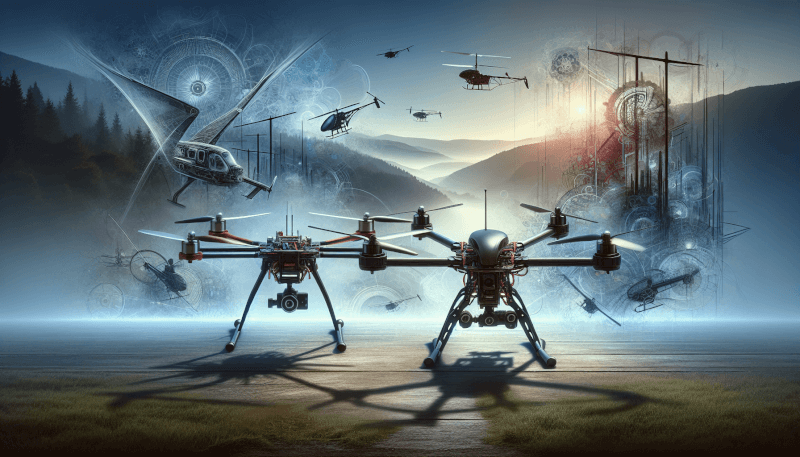Have you ever wondered about the differences between quadcopters and RC helicopters? In this article, we will explore the unique features and capabilities of both these remote-controlled flying machines. Whether you’re a beginner looking to get started in the world of aerial drones, or a seasoned enthusiast looking to expand your collection, understanding the distinctions between quadcopters and RC helis is key. From their flight control mechanisms to their maneuverability in the air, we will delve into the details that set these two types of aircraft apart. So, buckle up and prepare to take off into the fascinating world of remote-controlled flight!
Design and Structure
Quadcopters
Quadcopters are multirotor aircraft characterized by their four rotors arranged in a symmetrical pattern. The design of quadcopters allows for stable flight and easy maneuverability. They typically have a lightweight and compact frame, making them portable and easy to transport. Quadcopters often feature a built-in camera or a mounting system for attaching a camera, making them popular for aerial photography and videography. The design also allows for vertical takeoff and landing, making them versatile for various applications.
RC Heli
RC Heli, short for remote-controlled helicopter, is a single rotor or coaxial rotor helicopter that is controlled remotely by a transmitter. Unlike quadcopters, RC Helis have a different design and structure. They have a main rotor mounted on top and a tail rotor for flight stability and control. RC Helis come in different sizes and designs, ranging from small indoor models to large outdoor models. They are often more complex and require more skill to operate compared to quadcopters.
Number of Rotors
Quadcopters
As mentioned earlier, quadcopters have four rotors arranged in a symmetrical pattern. The use of four rotors provides increased stability, control, and maneuverability. The four rotors work together to create lift, allowing the quadcopter to hover, ascend, descend, and perform various flight maneuvers. The symmetrical arrangement of the rotors ensures balanced thrust distribution, contributing to the quadcopter’s stable flight characteristics.
RC Heli
RC Helis, on the other hand, can have either a single rotor or coaxial rotor system. Single rotor RC Helis have one main rotor responsible for lift and a tail rotor for stability and control. Coaxial rotor RC Helis have two rotors stacked on top of each other, with each rotor spinning in the opposite direction. The coaxial rotor system eliminates the need for a tail rotor and provides increased stability. The number of rotors in RC Helis affects their flight characteristics and maneuverability.

Flight Control
Quadcopters
Quadcopters have a wide range of flight control capabilities. They can hover in place, move in any direction, and perform various aerial stunts. Flight control of quadcopters is achieved through the adjustment of rotor speeds and the differential thrust between the rotors. Most quadcopters feature a built-in flight controller that regulates and stabilizes the aircraft during flight. Additionally, quadcopters often have different flight modes, such as GPS-assisted flight, altitude hold, and follow-me mode, which enhance their flight control capabilities.
RC Heli
RC Helis also offer flight control capabilities but in a different way. The pilot controls the flight of an RC Heli using a transmitter that sends signals to the helicopter’s receiver. The receiver, in turn, sends those signals to the servos, which control the rotor speed and position. The pilot’s control inputs determine the direction and speed of the helicopter’s movements. RC Helis require precise control inputs from the pilot, making them more challenging to fly compared to quadcopters.
Stabilization System
Quadcopters
Quadcopters have built-in stabilization systems that help maintain the aircraft’s stability during flight. These stabilization systems use various sensors, such as gyroscopes, accelerometers, and sometimes even GPS, to detect and correct any unwanted movements or deviations from the desired flight path. The stabilization system constantly adjusts the rotor speeds and thrust distribution to keep the quadcopter level and steady. This is especially important for capturing smooth aerial footage and performing precise maneuvers.
RC Heli
RC Helis typically do not have built-in stabilization systems like quadcopters. The pilot is responsible for maintaining the helicopter’s stability and controlling any unwanted movements. However, some higher-end RC Helis may have optional stabilization systems or flybarless systems that enhance stability and control. These systems use gyroscopes and accelerometers to detect and counteract unwanted movements. While the pilot still plays a crucial role in stabilization, these systems assist in making the flight smoother and more manageable.

Flight Maneuverability
Quadcopters
Quadcopters excel in flight maneuverability. Their four rotors provide a high degree of control and precision, allowing them to perform tight turns, rapid changes in direction, and even acrobatic maneuvers. The symmetrical arrangement of the rotors allows for quick and precise adjustments in flight attitude, making quadcopters highly maneuverable in various flight situations. This maneuverability makes them suitable for aerial photography, videography, and recreational flying.
RC Heli
RC Helis, especially the single rotor ones, offer impressive maneuverability capabilities. With the combination of main rotor control and tail rotor control, RC Helis can execute complex flight maneuvers, including loops, rolls, flips, and inverted flight. However, RC Helis require a higher level of piloting skill and experience to achieve smooth and precise maneuvers. The pilot must have a good understanding of collective pitch, cyclic input, and tail rotor control to effectively maneuver an RC Heli.
Control Mechanism
Quadcopters
Quadcopters are controlled through a transmitter that communicates with the aircraft’s receiver. The transmitter allows the pilot to control the quadcopter’s throttle, pitch, roll, and yaw. These controls enable the pilot to command the quadcopter’s movements in various directions and execute different flight maneuvers. Many quadcopters also incorporate advanced control features, such as GPS-assisted flight, waypoint navigation, and return-to-home function, which enhance the control mechanism and user experience.
RC Heli
The control mechanism of RC Helis relies on a transmitter-receiver system, similar to quadcopters. The transmitter sends control signals to the receiver, which then activates the servos responsible for controlling the main rotor, tail rotor, and other flight controls. The pilot uses the transmitter to manipulate the controls, including throttle, collective pitch, cyclic input, and tail rotor control, to maneuver the RC Heli. The control inputs must be precise and coordinated to achieve smooth flight and accurate control of the helicopter.

Ease of Use
Quadcopters
One of the key advantages of quadcopters is their ease of use. They are generally more user-friendly compared to RC Helis, making them accessible to beginners and recreational users. Quadcopters often feature intuitive controls and flight modes that simplify the flying experience. Beginner modes, altitude hold, and headless mode are some of the features that assist novice pilots in flying quadcopters. Additionally, quadcopters usually have stable flight characteristics, making them easier to control and navigate.
RC Heli
RC Helis, on the other hand, have a steeper learning curve and require more skill to operate. They are known to be more challenging due to their complex control systems and inherent instability. RC Helis demand precise control inputs and quick reflexes to maintain stability and maneuverability. Novice pilots may find it overwhelming to fly an RC Heli without prior experience. However, with dedication, practice, and proper guidance, individuals can master the art of flying an RC Heli and enjoy the unique challenges it presents.
Learning Curve
Quadcopters
Quadcopters have a relatively short learning curve, especially for those with no prior flight experience. With their stability and beginner-friendly features, quadcopters can be flown by beginners after a short familiarization period. Novice pilots can start with basic flight maneuvers, such as hovering and flying in a straight line, gradually progressing to more advanced maneuvers. The learning process can be enhanced by using flight simulators and following online tutorials or joining local flying clubs.
RC Heli
The learning curve for RC Helis is generally longer compared to quadcopters. Due to their complexity and higher piloting skill requirements, beginners often face challenges when starting with RC Helis. Learning to fly an RC Heli requires a solid understanding of aerodynamics, rotor mechanics, and flight dynamics. Novice pilots are advised to seek guidance from experienced pilots or join RC Heli training programs to learn the necessary skills and techniques. Patience, practice, and perseverance are essential to mastering RC Heli flying.

Application and Purpose
Quadcopters
Quadcopters have a wide range of applications and purposes. They are commonly used for aerial photography and videography, allowing users to capture stunning images and videos from unique perspectives. Quadcopters equipped with cameras also find applications in film and television productions, real estate marketing, and surveying. Additionally, quadcopters are used for recreational flying, racing, parcel delivery, search and rescue operations, and agricultural surveys. Their versatility and maneuverability make them suitable for various industries and purposes.
RC Heli
RC Helis are popular among hobbyists and enthusiasts who enjoy the challenges of piloting a helicopter. They are often used for recreational flying, aerobatics, and competition flying. RC Helis have a dedicated community of pilots who participate in events and competitions showcasing their piloting skills and customized helicopter designs. Some RC Helis are also equipped with cameras for aerial photography and video recording. RC Helis provide a unique and immersive flying experience that appeals to those passionate about helicopters and aviation.
Cost
Quadcopters
The cost of quadcopters varies depending on the model, features, and brand. Entry-level quadcopters designed for beginners can be relatively affordable, starting from around $50 to $100. As the features and capabilities increase, the price range also expands, going up to several hundred or even thousands of dollars for professional-grade quadcopters with advanced camera systems and flight automation features. The cost of additional accessories and spare parts should also be considered when budgeting for a quadcopter.
RC Heli
RC Helis generally have a higher price range compared to quadcopters. The cost of RC Helis depends on the size, complexity, and quality of the model. Entry-level RC Helis suitable for beginners can range from $100 to $500. More advanced and larger-scale RC Helis, often preferred by experienced pilots and enthusiasts, can cost anywhere from $500 to several thousand dollars. Additionally, the cost of spare parts, batteries, and other accessories should be factored in when considering the overall cost of owning and operating an RC Heli.
In conclusion, quadcopters and RC Helis have distinct differences in design, flight control, maneuverability, and ease of use. Quadcopters offer stability, easy control, and a shorter learning curve, making them accessible to beginners and suitable for aerial photography and recreational flying. RC Helis, on the other hand, require more piloting skill and have a steeper learning curve but provide a more realistic and immersive helicopter flying experience. The choice between quadcopters and RC Helis depends on individual preferences, skill level, intended purpose, and budget. Whether you prefer the simplicity and versatility of a quadcopter or the challenge and authenticity of an RC Heli, both aircraft offer exciting opportunities for aerial exploration and enjoyment.



